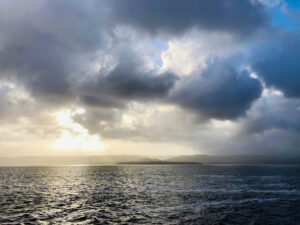Time for a statewide marine plan
Tasmania’s coastal waters are globally significant, and our island way of life is deeply embedded in our psyche. But our coastal waters are under threat from a range of pressures, including fishing, aquaculture, climate change and pollution.
Our east coast waters are warming four times faster than the global average. We have depleted fish stocks, ignored flow-on effects, excess nutrient loading, threatened species and paltry habitat protection. Land-based activities including the expansion and intensification of agriculture, pollution from runoff from industry, along with changes to freshwater and sediment flows, are also impacting the health of our marine environment. This all calls for fundamental improvement to our ocean management.
The recommendations of the long-awaited Upper House Inquiry into Fin Fish Farming provide a sensible and pragmatic approach to addressing concerns. The top recommendation is developing a comprehensive state-wide Marine Plan as well as a revised Salmon Industry Growth Plan. These are recommended to be developed through a process that considers all uses and users, is evidence based and includes environmental, social and recreational values assessments. This is well-timed and has the potential to bring together two review processes currently underway.
The first is the Tasmanian Government’s current review of the Living Marine Resource Management Act 1995, which provides for the sustainable development and protection of living marine resources in Tasmania. The law has not been reviewed since it came into effect 27 years ago when Telstra was still called Telecom Australia. As you can imagine, resource management has evolved significantly over that time and the law is out of date in a range of areas. It does not mention climate change, for a start, nor the precautionary principle – a fundamental tenant of modern resource management that calls for preventive action in the face of uncertain knowledge about risks.
The Report recommends this integrated approach should be achieved through marine spatial planning, a participatory process which includes all stakeholders in the planning exercise. Marine spatial planning includes interactive electronic mapping of all values and potential activities and is inclusive, open and evidence-based.
The second review processes already underway is the Salmon Industry Growth Plan. As the Upper House Report recommends, a revised Industry Growth Plan should be developed as one part of the Marine Plan. The Government is currently steaming ahead with the review of the Industry Growth Plan and aims to complete it by early next year.
To date, planning for aquaculture in Tasmania has not used comprehensive marine spatial planning. As IMAS has stated, their planning is designed to meet the needs of only one industry: fin fish farming. According to IMAS, there is no reason its planning could not be integrated into a more comprehensive planning process.
Integrated Ocean Management is practiced in many parts of the world, such as Canada, New Zealand and Europe. Closer to home, the Australian Government uses it offshore (from 3-200nm) and to co-manage the Great Barrier Reef. Other jurisdictions use it to varying degrees with Victoria currently providing the gold standard at the state level.
Victoria has reformed its marine and coastal management over recent years, with the aim of improving coordination and integration across all sectors. It’s not about reinventing the wheel. It’s simply a matter of bringing together existing laws and management plans into a cohesive and coordinated framework and leaving the silos behind. There is a lot we can learn from our nearest neighbours
Without consideration for all of our oceans’ values and activities, Tasmania’s globally significant marine life will continue to suffer.
The Tasmanian Government is yet to respond to the Inquiry’s recommendations. When it does, hopefully it will consider this once-in-a-generation opportunity to fundamentally improve ocean management for all industries and for all Tasmanians.
Between the Lines Newsletter
The biggest stories and the best analysis from the team at the Australia Institute, delivered to your inbox every fortnight.
You might also like
Have your say in the EPBC Act review of salmon farming in Macquarie Harbour
The Australia Institute Tasmania’s work was critical to triggering the federal EPBC review of salmon farming in Macquarie Harbour.
Letters to EPA, Department: Evidence demands state and federal action against fish farm licence renewals in Macquarie Harbour
The science is clear: Removing fish farming from Macquarie Harbour is an urgent priority to be actioned before this summer.
New Report Recommends Statewide Tasmanian Marine Authority
A new Independent Marine Estate Authority with whole-of-government oversight of Tasmania’s Ocean management would be established under a new proposal released today by the Australia Institute.

